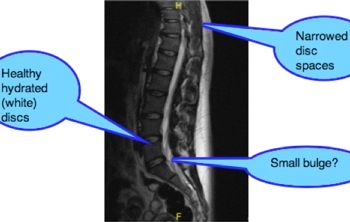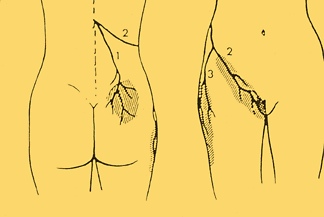Maigne's syndrome case file
Maigne's syndrome case file follows a 28-year old woman with a long history of low back pain.
A typical Maignes syndrome casefile includes mis-diagnosis. MRS S, a 28 year old woman has low back pain that radiates TO (so she said) the midback, but also into the right groin and the side of the thigh. The pain started 7 years ago, for no obvious reason, and has in the last year become decidely worse. She is miserable. Sport hurts, shopping hurts, sitting hurts.
Over the years she has been treated by a number of doctors, physios. She has been to an orthopedic surgeon and more recently a neurologist. She has been under treatment from a physical therapist for the last six months. And it just gets worse.
Her measure of how she is, is do bend straight sideways to the right. When her back is reasonable, she can reach the side of her knee without much restriction or pain in the back.
She was referred to me by said physical therapist six weeks ago. She couldn't reach the side of her knee. Not only was Mrs S miserable, she was also angry. Nobody could find anything wrong, and the implication was that her pain is firmly located between the ears.
The report that came with the MRI scan stated that it was a normal scan. However, on closer examination, the disc spaces in the upper lumbar spine were noticeably narrower, and the change from the lumbar lordosis, to a thoracic kyphosis was somewhat abrupt.

I have to say that I too was taken in by her presentation. She does have signs of lower lumbar pain and fixations, and she goes into an antalgic posture periodically, normally indicating an unstable lower lumbar disk. I was thinking of a postero medial disk herniation. However, certain facts didn't fit. For example the SLUMP TEST for Sciatica was quite negative.
The fact remains: I too was not thinking of a Maigne's Syndrome Casefile.
- Postero Medial Disk herniation - the sign of Pisa
What was unusual of her Maigne's Syndrome Casefile condition is that it was impossible to adjust (manipulate) her back. She reported that over the years no one could 'crack' her back. I couldn't either.
When she did not respond to my first two weeks of treatment, I started to look further, which I really should have done in the beginning. Doctors jump to conclusions; so did I. Motion palpation of the lumbo-thoracic junction was very fixated, and extremely painful to touch: a Maigne's syndrome with pain radiating to the lower back and the side of the leg as mediated by the Superior Cluneal nerves, and the Lateral Femoral cutaneous nerve?
Superior cluneal nerves

Maigne's syndrome case file
The pain was not radiating FROM the lower lumbar spine TO the thoracic spine, but FROM the thoraco-lumbar facets TO the low back and side of the leg.
Because two nerves, (actually there are others: FEMORAL NERVE Case File ) the Superior Cluneal nerves and the Lateral Femoral Cutaneous nerve both eminate from the T/L junction, Maigne's syndrome gets very mixed up with MERALGIA PARESTHETICA. It is a fine line, and there are many variables.
Now that we have the diagnosis right, she is
responding very nicely. It is early days, Aachen en Cologne were not built
in a day as we say in Holland, Rome too. But the anger is gone, my own
disquiet, and soon we'll be starting with the rehab.
Maigne's syndrome ... all the facts.
UPDATE: Mrs S is a very happy lady. She is getting her life
back, and slowly, slowly she is getting stronger and able to tackle more
things that behoove a young woman.
She's a bit lazy about the rehab exercises which I find frustrating. One would think that someone with a seven year history of lower back pain would be more faithful! But despite that, she now comes for a consultation once a month and is far better than she has been for years. Success. A cure? Nope, that does not exist with backs and a heap of medical conditions. Cure for diabetes, high blood pressure, hypothyroidism...?
Did you find this page useful? Then perhaps forward it to a suffering friend. Better still, Tweet or Face Book it.
